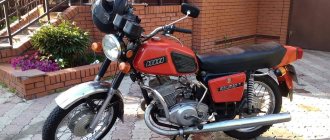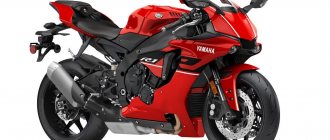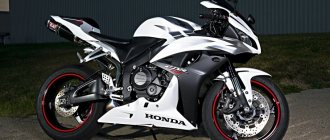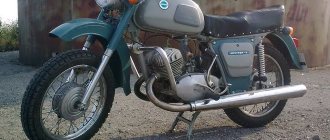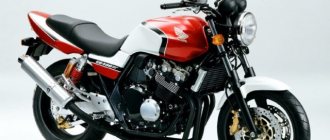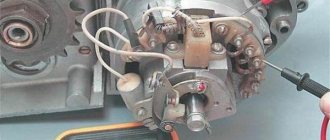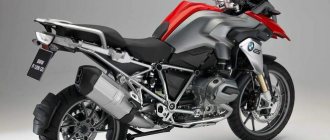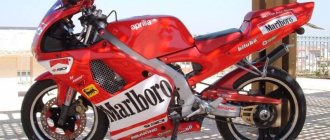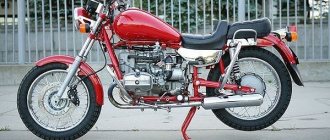Russian motorcyclesIZH motorcycles
The popularity of motorcycles is ensured by their small overall dimensions, lower fuel consumption than a car, and most importantly, very high maneuverability. And if we take modern motorcycles, then another advantage is their high speed performance.
Of course, now the roads are driven mainly by motorcycles from foreign manufacturers belonging to different classes. But some 20 years ago, only domestic motorcycles were seen on the roads.
The leaders on our roads were IZH motorcycles , represented by two models “Jupiter” and “Planet”. The manufacturers ran these two models in parallel; they had significant similarities, but there was one significant difference – the engine. “Planet” was equipped with a single-cylinder power unit, while “Jupiter” was equipped with a two-cylinder one.
The presence of two cylinders provided not only more power than the Planet, but also easier engine starting, since this unit did not have a return compression blow to the winding stem. Perhaps the best model was the IZH Jupiter-5, which should be considered in more detail.
Modifications
IZH "Jupiter" with index "5" came off the assembly line in 1985, two years earlier than the IZH "Planet-5" model. The appearance of the first Jupiter-5 was almost completely identical to its predecessor, Jupiter-4.
But the then new engine had slightly reduced power, but increased torque. Among the visible changes, Jupiter-5 was distinguished by a different finning of the cylinders, as well as a new flange mounting of the exhaust pipes.
IZH "Jupiter-5" was a middle-class motorcycle designed for traveling on roads with various surfaces. Three modifications of this motorcycle were produced.
The standard version was a modification without a side trailer, but equipped with fastenings for it, as well as a modification already equipped with a side trailer - a motorcycle with a sidecar.
The second modification was “Tourist”. This motorcycle was equipped with a side trailer; in addition, it had a spare wheel with increased lugs. This modification was designated as IZH “Jupiter-5T”.
The third modification was designated “Lux”, or IZH “Jupiter-5L”. This motorcycle was not equipped with a side trailer, and there were no fastening elements on the motorcycle for it. But it was equipped with a small fairing, there were also knee roll bars and a towed luggage rack.
Motorcycle design
But structurally the motorcycles of these modifications did not differ from each other.
All components of the motorcycle were mounted on a tubular frame. To provide suspension for the rear wheel, there was a subframe at the rear of the frame, attached to the frame by a non-rigid bolt connection. A power unit with a gearbox and a steering column equipped with a telescopic fork were installed on the front part of the frame. The fuel tank was located above the engine, and in front of it was the steering wheel, dashboard and headlight.
Behind the tank, the entire upper part of the motorcycle was allocated under the seat, with a rear fender with a brake light attached to it. Below the seat there were two glove compartments. The left one was for the battery, and the right one was for tools.
The rear wheel was installed on the existing subframe. To provide its suspension, the subframe, in addition to the non-rigid bolted fastening, was connected to the frame by means of spring-loaded oil shock absorbers. The springs had three-position adjustment, which provided a change in the rigidity of the rear suspension. The rear wheel was driven by a chain drive.
Exhaust pipes extending from the engine stretched along the entire motorcycle. To protect the driver and passenger from possible burns, the pipes were attached under the running boards.
The motorcycle was equipped with two-cam drum brakes with mechanical drive on both wheels. Subsequently, some versions were equipped with hydraulic front disc brakes.
Design
As already mentioned, the first IZH “Jupiter-5” did not differ in design from the IZH “Jupiter-4” model. But with the advent of the new IZh “Planet-5”, the designers decided to borrow some external elements from this motorcycle.
So, the shape of the dashboard has changed. Previously, it was square with a speedometer, warning lamps and an ignition switch located on it. The new instrument panel consisted of two combined wells. The speedometer was installed in the right one, the left one was used for warning lamps. The ignition switch was installed between the dashboard and the steering wheel.
The shape of the fuel tank has changed somewhat, and it again acquired rubber pads for the knees; the first versions of the IZH Jupiter-5 did not have them. Along with the tank, the shape of the side glove compartment lids also changed.
The most significant thing in the design of the IZH “Jupiter-5” was the appearance of a seat with a small extension that turns into a brake light. People call this seat “Bench”.
Subsequently, the designers redesigned the engine itself. Now IZH Jupiter-5 motorcycles are already equipped with water-cooled units, although its power has not changed.
Let's get to know the 1200 cc bandit from Japan in more detail: Suzuki Bandit 1200 is the hero of our article.
Don't want to leave your ATV for the winter? Install the tracks! Follow the link to find an overview of popular track models.
If there is no charging on the Izh Jupiter motorcycle.
This article was written to help those motorists who decided to find and fix a malfunction in the battery charging system on IZH 12V motorcycles themselves.
Of the special instruments, you will need the simplest tester with a continuity function (tweeter) and resistance measurement. If you do not have this device, then you can use a light bulb with a battery to determine the contact or break in the circuit.
In this case, you need to install a well-charged battery on the motorcycle, or power the on-board network from another external power source with a constant voltage of 12 V. First of all, we check the presence of voltage with the ignition switch on at the positive terminal of the regulator relay. There should be +12v.
If there is no voltage, then we look for a break from the positive terminal of the battery through the ignition switch and to the + terminal on the relay regulator.
Next, we measure the voltage on the brushes. There should be +12V on one of the brushes. If not, we call the wiring from the relay to the generator brushes.
Next step. We take the brushes out of the holder and ring each of them from the terminal to the graphite. It happens that at the point of contact of the wire with the graphite body of the brush itself, the contact is lost.
Troubleshooting the generator
Three phase wires are disconnected from the stator and the winding (connected to each other according to a star circuit) is connected. That is, the windings should ring with each other and have approximately the same resistance. If some winding does not ring, this means that there is a break and the stator is not working properly.
Next, all three phases are called relative to the body (mass). If it rings, it means the windings are broken into the housing and the stator is not working properly.
Anchor
We ring the armature winding (on copper rings). If the rings ring among themselves - good, if not - there is a break, the armature is not working.
The next step is to wire the armature winding relative to the armature body.
If it doesn’t ring, it’s good; if it rings, the winding is broken into the housing and the armature is not working properly!
That's it with the generator.
Relay regulator
If all the wiring is in order, the brushes, stator and rotor are ringing and everything is working, all that remains is the relay regulator! In my experience, even if you don’t have much knowledge of radio electronics, you can at least remove the back cover of the relay regulator and wipe off all the dirt. Carefully look at all the contacts, fastening parts, wires, jumpers; sometimes the contact or soldering simply falls off due to vibration. The diode bridge is practically “eternal”. But the control thyristors sometimes fly out! They are also called simply - to check for breakdown on the housing and between the cathode and the control electrode!
They are also easy to change; a 10 mm nut is unscrewed from below and the wires are unsoldered from above.
That's basically it. And there is absolutely no need to change entire components at random; there can be a lot of reasons, even banal bad contact on the chips or oxidation of the wires in the connector
The editors of the magazine thank Sergei Sharikov for kindly providing materials for the article.
If you have something to share with readers and would like to publish your story or photo report about your travels on our website, please send the materials to:
Technical characteristics of the motorcycle IZH "Jupiter-5"
If you compare the IZH Jupiter-5 with modern motorcycles, then the technical characteristics and performance of the Izhak are more than modest. All of them are shown in the table:
| Dimensions | |
| Length, mm | 2170 |
| Width, mm (without/with side trailer) | 810/2100 |
| Height, mm | 1170 |
| Engine - two-cylinder, two-stroke, air/water cooled | |
| Power, hp | 25 |
| Volume (cm. cubic meters) | 347,6 |
| Engine lubrication system | Together with oil |
| Ignition | Battery |
| Average gasoline consumption, l. (without/with side trailer) | 5,9/7,1 |
| Maximum speed (without/with side trailer) | 125/95 |
| Transmission | |
| Number of gears | 4 |
| Drive wheel | Chain |
| Clutch | Multi-disc, oil bath |
Experience with operating motorcycles of the IZH Planet and IZH Jupiter families can be found in the reference literature. Here you can find the family of domestically produced IZH motorcycles.
Engine IZH Jupiter
Relatively recently, motorcyclists became acquainted with the new road motorcycle “IZH Jupiter”.
Quite comfortable, easy to operate, reliable, and most importantly, with high dynamic and performance qualities, it is superior to its predecessor, the IZH-56. Take, for example, such an important indicator as maximum speed. At full load (driver and two passengers), the IZH Jupiter’s speed is 85-90 km/h, while the old model’s speed is 70 km/h. This speed, combined with good throttle response, is achieved mainly because the Jupiter has a more advanced engine than the IZH-56. Having the same working volume as the single-cylinder IZH-56 (346 cm3), the two-cylinder two-stroke IZH Jupiter develops significantly more power (by 5 hp), namely 18 hp. With. at 4900-5100 crankshaft revolutions per minute.
What are the design features of the new engine?
Compared to previously produced engines of this class, it is “short-stroke”, that is, it has a reduced ratio of the piston stroke (58 mm) to the cylinder diameter (61.75 mm). Thanks to this, it was possible to increase power by increasing the maximum number of revolutions at lower average piston speeds. Here is a typical example. If at maximum power mode the IZH-56 engine has an average piston speed of 12.2 m/sec at 4300 rpm, then the IZH Jupiter engine has an average piston speed of 5100 rpm. it is 9.85 m/sec. This reduction made it possible to reduce wear on pistons and cylinders, reduce friction losses, etc.
An increase in the compression ratio to 6.7–7.0 had a beneficial effect on improving power and economic indicators. This was also made possible due to the smaller cylinder diameter. As a result, the average effective pressure increased and fuel consumption decreased.
The IZH Jupiter engine is equipped with a plastic contact-oil air filter, which provides good air purification from dust, and therefore increases the service life of cylinders, pistons and piston rings. It is also a good muffler for intake noise. Less noise during operation, easier and faster starting of the IZ Jupiter engine increase the performance of the motorcycle.
A cross section of the IZH Jupiter engine is shown in the figure. Let us dwell on those components and parts that differ in design from the corresponding components and parts of the IZH-56.
The cylinder head is made of aluminum alloy. The presence of a large number of fins provides sufficient cooling surface. The spark plug is located in its central part. There is no gasket between the head and the cylinder.
The cylinder consists of an aluminum jacket and a pearlitic cast iron liner pressed into it. The shirt, which has a developed ribbed surface, is made by injection molding. There is one exhaust, four bypass and one inlet port located on the cylinder mirror. Two purge channels ensure the outlet of the working mixture at an angle of 45°, and the other two at an angle of 30°.
The plant produces three groups of cylinders, differing in internal diameter by 0.01 mm. The group number is located on the top outside of the cylinder outlet. The latter does not have plugs in the purge channels. A sealing gasket is installed between the cylinder and the crankcase. The inlet pipe is common to both cylinders.
The piston is made of KS-740 aluminum alloy with a high silicon content (16 to 22 percent), which provides a low linear expansion coefficient. Thanks to this, the thermal gaps between the cylinder and the piston are kept constant under different engine operating conditions.
There are two cast iron piston compression rings. The gap in the grooves between the piston and the ring ranges from 0.075 to 0.102 mm. Depending on the size, the pistons are also divided into three groups, according to which they are matched to the cylinders.
For better heat removal from the ring area, the piston walls opposite the grooves are thickened. This allows you to reduce the temperature in the groove area and almost eliminates burning and coking of the rings. On IZ Jupiter you can use pistons from Kovrovets-175 motorcycle engines.
The hollow piston pin with a diameter of 14 mm is made of 15X steel. Its seating in the piston bosses is floating when the engine is running, axial movement is limited by two retaining rings.
The design of the connecting rod ensures its durability. It is stamped from steel 12ХН2, has an I-section. A bronze bushing is pressed into the upper head. Two holes with a diameter of 6 mm are used to lubricate the piston pin. The connecting rod lower head bearing consists of 32 rollers measuring 4X6 mm, located in a brass cage.
The crankshaft consists of two separate shafts connected to each other by an external flywheel. Their relative position is determined using keys on the axle shafts. During assembly, the remote flywheel - a steel disk with a cut - is tightened with a bolt. The shaft of each cylinder is non-separable and has two steel cheeks with axle shafts. The axle shafts are connected to each other by a crank pin pressed into them.
The crankshaft rotates in four ball bearings, of which three are 205 series, and one, on the side of the drive motor sprocket, is 304 series. The 205 series bearings are lubricated from the crank chamber through holes in the crankcase, and the 304 series bearing is lubricated with oil directly from the gearbox. Yes .
The crankshaft is held against axial movement by retaining rings in the engine crankcase. The G-36M2 generator is attached to the right end of the crankshaft, and the driving motor sprocket is mounted to the left.
Engine torque is transmitted from the crankshaft to the clutch drive drum using a double-row bushing chain. The gear ratio of the motor transmission is 2.57.
The connecting rod and crank mechanism and all other units and components of the engine, the gearbox are located in an aluminum crankcase, consisting of two halves, with a connector along the longitudinal axis. During assembly, both halves are fixed with mounting sleeves and fastened with screws. On the side of the remote flywheel, aluminum crank chamber covers are attached to each half with screws. Rubber rings are placed between them to seal
A clutch cover with a hatch is attached to the left half of the crankcase. Through it, if necessary, you can tighten the clutch springs, as well as pour oil into the gearbox. The generator cover, which also has a hatch, is attached to the right half of the crankcase. It provides access to the generator for adjustments.
The clutch design is basically the same as on the IZH-56 motorcycle. The difference is that the outer drive drum is mounted on a ball bearing. This allows you to reduce its backlash and distortions during operation, increase the reliability and service life of the clutch drive discs.
The IZH Jupiter motorcycle uses an automatic clutch release device. At the end of the shift mechanism shaft there is a machine cam, which has two bevels, along which the lever moves, located on the bracket (it is attached to the right crankcase cover). When you press the pedal, the shaft of the shift mechanism rotates together with the cam of the machine and, thanks to the existing bevels, moves the lever. The latter presses the pusher: the clutch is disengaged and then the corresponding gear is engaged.
You can engage the clutch with a lever located on the steering wheel, as on the IZH-56, or with the gear shift pedal.
Great convenience is created by the double-shouldered lever, which allows you to change gears with both the toe and heel of the foot. The gearbox has the following gear ratios: I gear - 3.17, II - 1.71, III - 1.26, IV - 1.0.
The IZH-56 and IZH Jupiter gearboxes are identical in design, they differ only in the switching mechanism. After the clutch is disengaged, when changing gears on the IZH Jupiter motorcycle, the sector fixed to the mechanism shaft uses an anchor to rotate the worm shaft. The latter has shaped grooves into which the projections of the shift forks fit. When the worm shaft rotates, the forks move axially. They move gears. As a result, the corresponding gear is switched on or off.
The IZH Jupiter engine is equipped with a K-28Zh carburetor, which has a main fuel jet with a capacity of 270 cm3/min. The ignition timing is set within 2.2-2.6 mm before TDC. The engine is mounted on the motorcycle frame at three points, two at the front and one at the rear.
The IZH Jupiter motorcycle is produced with a side trailer, but can be used without it. In the first case, a sprocket with 16 teeth must be installed on the secondary shaft of the engine, and in the second - with 18 teeth.
Many parts and components of the IZH Jupiter and IZH-56 engines, for example the secondary shaft, drive and driven clutch discs, some gearbox gears, and the starting mechanism, are unified. It is very convenient to use.
These are the main design features of the IZH Jupiter engine. An article in one of the next issues of the magazine will be devoted to its care and operation.
V. ABRAMYAN,
engineer, public correspondent for the magazine “Behind the Wheel” at the Izhevsk Machine-Building Plant.
Approximate price for IZH Jupiter 5
Despite such indicators, this motorcycle was in good demand among the people. He did not participate in major international competitions; for this there were other models of motorcycles. And it was not intended for competitions; its main task was a comfortable ride on any road .
In Soviet times, IZH Jupiter-5 was sold at a price of 1050 rubles. For comparison, the new heavy Ural motorcycle cost almost twice as much - 1,870 rubles.
Now this motorcycle, new and without mileage, will cost 55,000 rubles. Although you can also purchase IZH “Jupiter-5” with mileage. The price for it depends on the condition of the motorcycle itself, as well as the year of production, and it ranges from 3,000 to 40,000 rubles.
For lovers of domestic products, ATVs[/anchor] and all-terrain vehicles will be of interest from ]Russian mechanics. High quality, popular.
The smallest of the Bandits from the Suzuki company is disassembled in detail at the link. Let's tell you more about one of the most reliable motorcycles.
Photos
The IZH Jupiter 5 motorcycle, as stated above, has been in production since 1985 and is now quite rare on our roads. It's quite difficult to find a motorcycle in good condition. But just recently, similar models of motorcycles were found almost everywhere. Let's see what it looked like.
DEVICE AND PRINCIPLE OF OPERATION OF THE IZH-YU5K ENGINE
The two-cylinder, two-stroke, carburetor, liquid-cooled engine has a cylinder-piston group, a crank mechanism, providing gas distribution (intake, exhaust and purge) without auxiliary mechanisms.
A liquid-cooled engine compares favorably with counter-air cooling, as it can operate in any mode for a long time, showing stable technical and economic characteristics.
The cooling system operates automatically, thereby maintaining the optimal thermal conditions of the engine. The automatic mode of operation of the cooling system is as follows: with a cold engine (coolant temperature up to 60 ° C), the thermostat windows are closed, and the air fan is turned off, the coolant passes through small holes in the thermostat before entering the radiator.
When the engine is warm (coolant temperature 80°C), the coolant passes through the large (opened) windows in the thermostat before entering the radiator.
Rice. 4. Installation of the expansion tank.
1 – left radiator cushion, 2 – right radiator cushion, 3 – screw BM5-6exl6.58.019 GOST 17473-80, 4 – nut M5.6S.8.016 GOST 5927-70, 5 – washer 5.65G.019 GOST 6402-70, 6 – washer S5.04.019 GOST 6958-78, 7 – bolt M6-6ex25.88.35.019 GOST 7805-70, 8 – nut Mb.6S.8.016 GOST 5927-70, 9 – washer 6.65G.019 GOST 6402-70 , 10 – washer C6.04.019 GOST 6958-7S, 11 – bushing, 12 – strap nut.
The automatic coolant temperature maintenance system includes:
- horizontal tubular-band cooling radiator;
- water pump driven by crankshaft sprocket (left);
- thermostat;
- an air fan with an electric motor powered by an engine generator;
- thermal switch;
- relay;
- temperature sensor and connecting hoses.
The gearbox is four-speed.
The transmission of torque to the gearbox from the crankshaft is ensured by a double-row bushing chain through the clutch.
The transmission from the gearbox to the drive wheel is carried out by a chain drive from the sprocket of the secondary shaft of the gearbox.
The gear shift mechanism includes: a worm shaft with forks assembled, a shift shaft assembly with a driver, an anchor, a shift sector and an anchor stop limiting the rotation of the sector, a gear shift pedal (foot pedal).
Is the clutch manually controlled by the clutch lever on the left side? steering wheel and automatic - from the gear shift pedal (for a motorcycle).
Engine installation.
The engine is installed on IZH-Jupiter K motorcycles in accordance with the YZH-YU5K sb layout. 1-08 (Fig. 2).
Install relay 1 on the frame using an M5 bolt connection, having previously drilled a hole in the frame bracket. hole with a diameter of 5.5 mm, maintaining the distance “C1” (Fig. 2).
Rice. 6. Gearbox.
1 – primary fork, 2 – 2nd gear gear, 3 – 2nd and 4th gear gear, 4 – secondary shaft gear. 5 – gear shift sector, 6 shift shaft, 7 – worm shaft, shift fork for 2nd and 4th gears, 9 – shift fork for 1st and 3rd gears. 10 – intermediate shaft gear. 11 – 3rd gear gear, 12 – 1st and 3rd gear gears, 13 – 1st gear gear, 14 – intermediate shaft.
Install expansion tank 7 (Fig. 2) in the instrument compartment (on the right side), for which:
Lubricate end “B” of the expansion tank with paint (Fig. 4).
Place the expansion tank in the instrument compartment in this way. so that surface A (Fig. 2) is located horizontally, and surfaces B and C of the tank touch the walls (vertical and bottom) (Fig. 2) and then in this position move the tank to wall “U” (Fig. 4) until it stops to the last one and take a print of end “B”. From the center of the taken print on the wall “U”, drill a hole with a diameter of 11 mm.
Rice. 7.
Carburetor.
1 – “quality” screw
2 – “quantity” screw
Insert the protrusion “F” (Fig. 4) of the expansion tank into the drilled hole with a diameter of 11 mm until it stops, while surface A (Fig. 2) must be horizontal. Using holes with a diameter of 5.8 mm in the mounting ears of the tank, drill two holes with a diameter of 5.5 mm in place in the wall “U” (Fig. 4).
Secure the expansion tank to the wall “U” using M5 screws and nuts.
Install the engine onto the frame.
Install radiator 8 (Fig. 2) on the ribs of the engine exhaust pipes, placing the left radiator pads 1 and right 2, respectively (Fig. 4).
Insert two dampers 12 into protection 10 (Fig. 2).
Install the protection on the radiator using an M6 bolt connection, having previously assembled bolts, washers (flat and spring) and bushings 11 on the protection; we recommend fastening the strip nuts 12 after preliminary tightening the outer bolts with nuts (Fig. 4).
Attach hose 5 to the expansion tank and radiator and secure it to the frame with two clamps 4 (Fig. 2).
Connect supply hose 13 to the radiator and water pump and secure it with clamps 11 (Fig. 2).
Attach two hoses 9 to manifold 6, and then put the latter on the cylinder covers. Secure clamps 14 (Fig. 2).
Attach the outlet hose to the radiator and manifold 3. Secure the clamps.
Connect the fan harness 2 (Fig. 2) in accordance with the electrical connection diagram for the fan harness (Fig. and (Fig. 9).
and (Fig. 9).
Video
The video below shows a test drive of the motorcycle in the field, both on a dirt road and on asphalt. The motorcycle is specifically designed for off-road travel; under such conditions, this motorcycle can be a worthy competitor to foreign brands.
Did you like the article? Tell your friends!
Comments (6)
- Vitaly:
02/27/2015 at 17:49A Soviet motorcycle that has remained virtually unchanged over the years. It still has valveless primitive injection. You shouldn't expect much from him. Small motor lifespan. Always painful.
Answer
- Zolotoiy:
02/28/2015 at 11:09
Of all the motorcycles that I have had, and there were quite a few of them, IZH U5 is a song 25 horses, semi-automatic box, playful, powerful, but like a parody dog, it requires care, who will say it’s rash, you need to keep an eye on it, that’s all, and I recommend it to everyone
Answer
- sergmayorov:
03/02/2015 at 12:46
My friends, IZH U5 is still in my garage and drives steadily. Of all the Soviet-era motorcycles, this is the best. It lends itself to any tuning, the power is enough, the clutch is eternal. By the way, it holds the road better than a Java, since it is heavier. The spare parts are all domestic and cost a penny. However, the chances of crashing in this way are much less than in Japanese.
Answer
- Jahanger:
05/15/2015 at 20:20
My friends, IZH Yu5 is still in my garage and drives steadily. Of all the Soviet-era motorcycles, this is the best. It lends itself to any tuning; the power is enough to last forever.
Answer
- Vitaly:
07/04/2015 at 20:00
I have an Izh Jupiter 5 in my garage and it works like a watch, although it is 26 years old and its maximum speed is not 125 km per hour, but 160 km per hour, you just need to put 275 jets and a 21 sprocket on the chain, it will actually eat more.
Answer
- allvolley.ru:
08/17/2016 at 11:03
There is still such a device! And the condition is excellent, and quite nimble)
Answer
Why does the IZh motorcycle not start?
Motorcycle malfunctions - the engine does not start
The engine may also not start if there is excess fuel in the cylinders, especially on a hot engine.
There is no sparking on the spark plug electrodes
After making sure that the ignition key is inserted all the way (the control lamp is on and the signal is working), unscrew the spark plugs, check the gap between the electrodes and, connecting their bodies to ground, press the trigger lever several times. If there is a fairly good spark between the electrodes of the spark plugs, then the cause of the malfunction should be sought in the engine power system.

